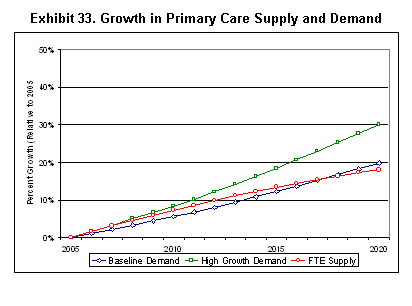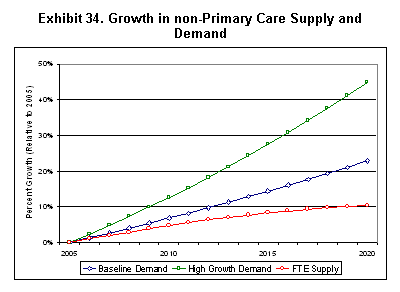Assessing
the Adequacy of Current and Future Supply
The PRM uses current patterns of healthcare
use and delivery of care to project future demand for physician
services. This utilization-based approach relies on the
assumption that healthcare utilization and service delivery
patterns in the base year (2000) are “adequate.” That is,
the PRM relies on the implicit assumption that physician
supply is in balance with physician requirements in the
base year at the national level. Inefficiencies in the market
resulting from current oversupply or undersupply of physicians
are extrapolated into the future.
 [D]
[D]
The baseline
projections suggest that if current trends continue, overall
primary care physician supply and requirements will grow
at about the same rate over the next 15 years at which time
requirements will grow faster than supply (Exhibit 33).
These national projections mask the geographic variation
in adequacy of supply. HRSA estimates that approximately
7,000 additional primary care physicians are currently needed
in underserved areas to de-designate federally-designated
shortage areas.
 [D]
[D]
Because the national
supply of primary care physicians is growing at roughly
the same rate as requirements, there will likely be little
change in market pressures to improve the undersupply of
primary care physicians in rural and other underserved communities.
Under the high-demand growth scenario, growth in demand
for primary care physicians exceeds growth in supply. Between
2005 and 2020, demand for non-primary care physicians will
grow faster than supply (Exhibit 34). These national projections
mask the projected inadequacies in individual specialties,
with specialties such as general surgery, urology, ophthalmology,
cardiology, pathology, orthopedic surgery, other internal
medicine subspecialties, otolaryngology, radiology, and
psychiatry seeing demand grow much faster than supply.
|